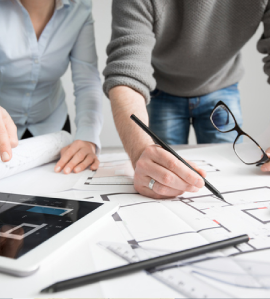How Architecture Impacts Us
power of architecture. Architects strive to put their finger on it. Our perception of space is often on a conscious, even primal level. Because I see the world through 5 Senses Design, I consider how a space looks, feels, sounds, smells and tastes. I think we easily feel the volume of the space, but there’s so much more. Ultimately, 5 Senses Design enhances meaningful experiences.
When I walk into a grand spiritual space, its high volume takes my breath away. The cathedrals I visited in England resonate with my focus on the senses and nature. Their thick walls contrasted with colored stained-glass windows, which filtered the light beautifully. “Oh, my gosh, I’ve never seen this before,” I thought, and I expect others throughout history arrived at similar impressions.
While England’s ancient cathedrals fascinate me, my family’s church comes to mind. We attended Christ Church in Oyster Bay, New York. I could smell, feel, and to some degree taste the massive masonry walls and the slate floor. I caught a whiff of its age. The rich-stained oak pews felt smooth, almost soft with age. The Procession would burn candles and incense during the service for the congregation. As a child, I’d spend a lot of time staring at the trusses and out the stained-glass windows. The acoustics played a major role in this spiritual experience. I was struck by how well I could hear the choir; yet I barely noticed someone jostling a paper nearby. The building’s design allowed the music to soar, and the “small” sounds to filter into the background. Though I hadn’t coined the term yet, I realized at a young age that 5 Senses Design enhances meaningful experiences.
Some people are captured by an outdoor stadium in a similar way. Engulfed by the natural light’s warmth and the smell of popcorn, they may not even be aware of the physical structure that forms the basis of the experience. Yet a space doesn’t have to be big to be interesting. A small, well-designed room possesses the same power. Biophilically speaking, a space feels different when a large glazed window reveals the exterior and diffuses the light. Rather than drop a shade on that window, one enjoys the light reflecting in, letting the outdoors in and the indoors out. When you experience a pleasing interaction in a certain place and with certain people, you’re also experiencing the impact of architecture.
For me, I feel the most connected in nature. At the bottom of the Grand Canyon, I found it similar to an illuminated cave, its walls reminiscent of a room and the clouds overhead like a cotton ceiling. Likewise, wooded trails feel like passages, as the canopy of trees forms an arched tunnel. Even roads up and down the east coast create spiritual spaces rife with connection.
Our design approach looks to bring some of the outside to the interior of the home, and it has a positive impact on the sense of well-being. The moment you open your front door and step out, you may feel just as connected to nature. “Wow, it’s such a beautiful day, a beautiful world.”
Wouldn’t it be wonderful if you could have that same level of appreciation inside your home? I try to bring some of that understanding inside. What would that add to a work environment, or a home, or a dinner party? Creating an outdoor living space that feels like you are inside, or an inside living space that feels like you are outside bridges that gap and reduces the container to a transparent level. The 5 Senses Design approach enhances meaningful experiences through architecture. Any place you can be at peace with your thoughts and inspired by your surroundings can be a sanctuary. Whether it’s a church or stadium, a mountain peak or your own home, it is particular the resonance with all 5 Senses that brings it about. I welcome that feeling in my home design. Let’s make your home your sanctuary.
Michael J. Roosevelt


